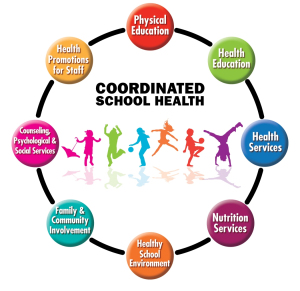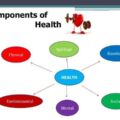
In Nigeria, the school health programmes are designed to ensure that students are as healthy as possible and to obtain the maximum benefit from education with the learning environment safe and conducive for learning. The school Health services are grouped under preventive and curative services provided for the pupils and staff within the school setting. Health education motivates students to improve and maintain their health, prevent disease and reduce risky behaviour. It is essential to start teaching health education in Nigerian schools early on from preschool to elementary and then to secondary. The programme comprises of various components which includes;
- School health services
- Health Education and Promotion
- Nutrition services
- Healthy school environment
- Physical Education
- Counseling& Psychological Services
General Components Of School Health Programme
Healthy and Safe School Environments: The physical and aesthetic surroundings and the psychosocial climate and culture of the school. Factors that influence the physical environment include the school building and the area surrounding it, and biological or chemical agents that are detrimental to health, and physical conditions such as temperature, noise and lighting. The psychological environment includes the physical, emotional, and social conditions that affect the well-being of students and staff.
Comprehensive School Health Education: A planned, sequential, curriculum that addresses the physical, mental, emotional, and social dimensions of health. The curriculum is designed to motivate and assist students to maintain and improve their health, prevent disease, and reduce health-related risk behaviors. It allows students to develop and demonstrate increasingly sophisticated health-related knowledge, attitudes, skill, and practices. The health education curriculum includes a variety of topics such as personal health, family health, community health consumer health, environmental health, sexuality education, mental and emotional health, injury prevention and control of disease, and substance use and abuse. Qualified, trained teachers provide health education.
Physical Education And Activity: A planned, sequential curriculum that provides cognitive content and learning experiences in a variety of activity areas such as basic movement skills; physical fitness; rhythms and dance; and aquatics. Quality physical education should promote, through a variety of planned physical activities, each student’s optimum physical, mental, emotional, and social development, and should promote activities and sports that all student enjoy and can pursue throughout their lives. Qualified, trained teachers teach physical activity.
School Health Services: Services provided for students to appraise, protect, and promote health. These services are designed to ensure access or referral to primary health care services for both, foster appropriate use of primary health care services, prevent and control communicable disease and other health problems, provide emergency care for illness or injury, promote and provide educational and counseling opportunities for promoting and maintain individual, family, and community health. Qualified professionals such as physicians, nurses, dentists, health educators, and other allied health personnel provide these services.
Nutrition Services: Access to a variety of nutritious and appealing meals that accommodate the health and nutrition needs of all students. School Nutrition programs reflect the U.S. Dietary Guidelines for Americans and other criteria to achieve nutrition integrity. The school nutrition services offer students a learning laboratory for classroom nutrition and health education, and serve as a resource for linkages with nutrition-related community services. Qualified child nutrition professional provide theses services.
School Counseling, Psychological And Social Services: Services provided to improve student’s mental, emotional, and social health. These services include individual and group assessment, interventions, and referrals. Organizational assessment and consultation skills of counselors and psychologists contribute not only to the health of students but also to the health of the school environment. Professionals such as certified school counselors, psychologists, and social workers provide these services.
Student, Family and Community Involvement In Schools: An integrated school, parent, and community approach for enhancing the health and well-being of students. School health advisory council, coalitions, and broadly based constituencies for school health can build support for school health program efforts. Schools actively solicit parent involvement and engage community resources and services to respond more effectively to the health-related needs of students.
Health Promotion For School Staff: Opportunities for school staff to improve their health status through activities such as health assessment, health education health-related fitness activities. These opportunities encourage school staff to pursue a healthy lifestyle that contributes to their improved health status, improved moral, and a greater personal commitment to the schools’ overall coordinated health program. This personal commitment often transfers into greater commitment to the health of students and creates positive role modeling. Health Promotion activities have improved productivity, decreased absenteeism, and reduced health insurance costs. ALSO READ: Components Of Primary Health Care




